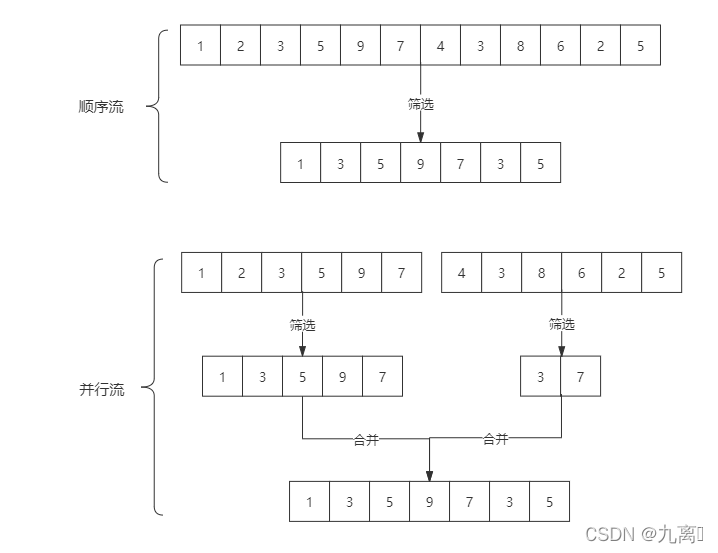什么是Stream流
Java 8 引入的 Stream API 是一个革命性的特性,它为集合操作提供了一种更高效、更简洁的方式。配合同版本的lambda表达式的出现,我们操作集合(Collection)提供了极大的便利。Stream 是 Java 8 中处理集合数据的抽象概念,它不是一个数据结构,而是一个来自数据源的元素队列并支持聚合操作。
Stream 将要处理的元素集合看作一种流,在流的过程中,借助 Stream API 对流中的元素进行操作,比如:筛选、排序、聚合等。
Stream 允许你以声明式方式处理数据集合,将复杂的数据处理任务转化为一系列简单的操作链。
这里的流指的是一系列元素的序列,它可以在一次遍历的过程中逐个处理这些元素。在Java中,流是对数据的抽象,可以操作各种不同类型的数据源,如集合、数组、文件等。
Stream可以由数组或集合创建,对流的操作分为两种:
中间操作,每次返回一个新的流,可以有多个。(筛选 filter、映射 map、排序 sorted、去重组合 skip—limit)
终端操作,每个流只能进行一次终端操作,终端操作结束后流无法再次使用。终端操作会产生一个新的集合或值。(遍历 foreach、匹配 find–match、规约 reduce、聚合 max–min–count、收集 collect)
Stream 的特点
- 不存储数据:Stream 是对数据源的视图,不存储元素。
- 函数式编程:所有操作都返回 Stream 或最终结果,不修改原始数据。
- 延迟执行:中间操作(如
filter、map)是延迟的,直到终止操作(如collect、forEach)才执行。 - 可消费性:Stream 只能被消费一次,消费后需要重新创建。
Stream与传统遍历对比
几乎所有的集合(如 Collection 接口或 Map 接口等)都支持直接或间接的遍历操作。而当我们需要对集合中的元素进行操作的时候,除了必需的添加、删除、获取外,最典型的就是集合遍历。
这里的遍历实际上不只是一一列举,可以是对其中的元素一一操作
如果我们从列表中筛选出长度大于 3 的字符串,并转换为大写
普通的写法就是如下
1 | List<String> names = Arrays.asList("Tom", "Alice", "Bob", "Charlie"); |
使用 Stream 流效果如下
1 | List<String> names = Arrays.asList("Tom", "Alice", "Bob", "Charlie"); |
在正常情况下,如果数值可能出现null,我们肯定需要处理
1 | List<User> users = Arrays.asList( |
而在 Stream 中,这个处理十分简便而且清晰,代码更健壮
1 | List<String> names = users.stream() |
Stream 的创建
从集合创建
1
2
3List<String> list = Arrays.asList("a", "b", "c");
Stream<String> stream = list.stream(); // 顺序流
Stream<String> parallelStream = list.parallelStream(); // 并行流从数组创建
1
2int[] array = {1, 2, 3};
IntStream intStream = Arrays.stream(array);使用
Stream.of()1
Stream<String> stream = Stream.of("a", "b", "c");
创建无限流:
iterate()、generate()1
2
3
4
5// 迭代生成无限流(从 0 开始,每次加 2)
Stream<Integer> evenNumbers = Stream.iterate(0, n -> n + 2);
// 生成随机数无限流
Stream<Double> randoms = Stream.generate(Math::random);从文件创建
1
2
3
4
5try (Stream<String> lines = Files.lines(Paths.get("file.txt"))) {
lines.forEach(System.out::println);
} catch (IOException e) {
e.printStackTrace();
}
Stream 的各种操作
我建议大家学会 Optional
类再来,那也在这里简单介绍一下吧,Optional类是一个可以为null的容器对象。如果值存在则isPresent()方法会返回true,调用get()方法会返回该对象。
Stream 操作分为中间操作和终止操作:
中间操作(返回新的 Stream)
过滤:
filter(Predicate<T>)按照一定的规则校验流中的元素,将符合条件的元素提取到新的流中的操作。
1
2
3
4List<String> names = Arrays.asList("Alice", "Bob", "Charlie");
names.stream()
.filter(name -> name.length() > 4) // 保留长度大于 4 的元素
.forEach(System.out::println); // 输出:Alice, Charlie映射:
map(Function<T, R>)接收一个函数作为参数,该函数会被应用到每个元素上,并将其映射成一个新的元素。
1
2
3
4List<Integer> numbers = Arrays.asList(1, 2, 3);
numbers.stream()
.map(n -> n * 2) // 将每个元素乘以 2
.forEach(System.out::println); // 输出:2, 4, 6扁平化:
flatMap(Function<T, Stream<R>>)接收一个函数作为参数,将流中的每个值都换成另一个流,然后把所有流连接成一个流。
1
2
3
4
5
6
7List<List<Integer>> nestedList = Arrays.asList(
Arrays.asList(1, 2),
Arrays.asList(3, 4)
);
nestedList.stream()
.flatMap(List::stream) // 将嵌套列表展开为单个流
.forEach(System.out::println); // 输出:1, 2, 3, 4排序:
sorted()或sorted(Comparator<T>)1
2
3
4List<String> names = Arrays.asList("Charlie", "Alice", "Bob");
names.stream()
.sorted() // 自然排序
.forEach(System.out::println); // 输出:Alice, Bob, Charlie去重:
distinct()1
2
3
4List<Integer> numbers = Arrays.asList(1, 1, 2, 2, 3);
numbers.stream()
.distinct() // 去重
.forEach(System.out::println); // 输出:1, 2, 3截断:
limit(long n)和skip(long n)1
2
3
4
5List<Integer> numbers = Arrays.asList(1, 2, 3, 4, 5);
numbers.stream()
.skip(2) // 跳过前 2 个元素
.limit(2) // 取接下来的 2 个元素
.forEach(System.out::println); // 输出:3, 4原始类型映射:
将元素映射为原始类型(如
int、long、double)的流,避免装箱拆箱开销。1
2
3List<String> strings = Arrays.asList("1", "2", "3");
IntStream intStream = strings.stream()
.mapToInt(Integer::parseInt); // 映射为 IntStream匹配转换(Optional 映射)
1
2
3
4
5
6List<String> names = Arrays.asList("Alice", null, "Bob");
names.stream()
.flatMap(name -> Optional.ofNullable(name)
.map(Stream::of)
.orElseGet(Stream::empty)) // 过滤 null
.forEach(System.out::println);截断(分页):
skip()和limit()1
2
3
4
5
6
7
8List<Integer> numbers = Arrays.asList(1, 2, 3, 4, 5);
List<Integer> limited = numbers.stream()
.limit(3) // 取前3个元素
.collect(Collectors.toList()); // [1, 2, 3]
List<Integer> skipped = numbers.stream()
.skip(2) // 跳过前2个元素
.collect(Collectors.toList()); // [3, 4, 5]
终止操作(返回最终结果或 void)
遍历:
forEach(Consumer<T>)此时
Stream中的元素是以Optional类型存在的。Stream的遍历、匹配非常简单。1
2List<String> names = Arrays.asList("Alice", "Bob");
names.stream().forEach(System.out::println); // 输出:Alice, Bob收集:
collect(Collector<T, A, R>)把一个流收集起来,最终可以是收集成一个值也可以收集成一个新的集合。
1
2
3
4List<String> names = Arrays.asList("Alice", "Bob", "Charlie");
List<String> filteredNames = names.stream()
.filter(name -> name.length() > 4)
.collect(Collectors.toList());统计:
count(),min(Comparator<T>),max(Comparator<T>)1
2
3List<Integer> numbers = Arrays.asList(1, 2, 3, 4, 5);
long count = numbers.stream().count(); // 5
Optional<Integer> max = numbers.stream().max(Integer::compareTo); // 5匹配:
anyMatch(Predicate<T>),allMatch(Predicate<T>),noneMatch(Predicate<T>)1
2List<Integer> numbers = Arrays.asList(1, 2, 3);
boolean hasEven = numbers.stream().anyMatch(n -> n % 2 == 0); // true查找:
findFirst(),findAny()1
2List<Integer> numbers = Arrays.asList(1, 2, 3);
Optional<Integer> first = numbers.stream().findFirst(); // 1归约:
reduce(T identity, BinaryOperator<T>)1
2List<Integer> numbers = Arrays.asList(1, 2, 3);
int sum = numbers.stream().reduce(0, (a, b) -> a + b); // 6
Collectors 工具类
Collectors 提供了常用的收集器实现,用于将 Stream
结果转换为集合或其他数据结构:
收集到集合
1
2List<String> list = stream.collect(Collectors.toList());
Set<String> set = stream.collect(Collectors.toSet());连接字符串
1
String joined = stream.collect(Collectors.joining(", ")); // "a, b, c"
分组
1
2
3Map<Integer, List<String>> lengthGroups = names.stream()
.collect(Collectors.groupingBy(String::length));
// 结果:{3=[Bob], 5=[Alice], 7=[Charlie]}分区(Partitioning)
1
2
3Map<Boolean, List<Integer>> evenOdd = numbers.stream()
.collect(Collectors.partitioningBy(n -> n % 2 == 0));
// 结果:{false=[1, 3], true=[2, 4]}统计
1
2
3IntSummaryStatistics stats = numbers.stream()
.collect(Collectors.summarizingInt(Integer::intValue));
// 包含 count, sum, min, max, average
流的并行化—Stream和parallelStream
stream是顺序流,由主线程按顺序对流执行操作,Stream
上的所有操作按顺序在单线程中执行。处理少量数据时,顺序流的开销更低。
而parallelStream是并行流,内部以多线程并行执行的方式对流进行操作,利用
Java
的ForkJoinPool将数据分成多个块,在多个线程中并行处理,但前提是流中的数据处理没有顺序要求,除非显式调用sequential()或使用forEachOrdered()。而且操作不依赖元素顺序或外部状态(如filter、map)。
| 特性 | Stream(顺序流) | parallelStream(并行流) |
|---|---|---|
| 执行方式 | 单线程顺序执行 | 多线程并行执行 |
| 线程池 | 无需线程池 | 默认使用ForkJoinPool.commonPool() |
| 元素顺序 | 保持顺序 | 不保证顺序(除非显式调用forEachOrdered()) |
| 性能 | 小数据量或 IO 密集型任务更优 | 大数据量且 CPU 密集型任务更优 |
| 线程安全 | 无需考虑 | 需确保操作线程安全(如避免共享可变状态) |
| 适用场景 | 简单操作、依赖顺序、IO 密集型 | 复杂计算、大数据量、CPU 密集型 |
例如筛选集合中的奇数,两者的处理不同之处:

使用 Collection.parallelStream()
方法直接创建并行流,元素可能由不同线程并行处理,顺序不固定。
1 | List<String> list = Arrays.asList("apple", "banana", "cherry", "date"); |
同理, Arrays.parallelStream() 方法也能创建并行流
1 | int[] array = {1, 2, 3, 4, 5}; |
通过 Stream.parallel()
方法将已有的顺序流转换为并行流。
1 | List<Integer> numbers = Arrays.asList(1, 2, 3, 4, 5); |
无限流也能并性化,无限流必须配合 limit()
等终止操作,否则会无限运行。
1 | Random random = new Random(); |
默认情况下,并行流使用公共的
ForkJoinPool.commonPool(),你也可以指定自定义线程池:
1 | List<Integer> numbers = Arrays.asList(1, 2, 3, 4, 5); |
并行流的注意事项
- 线程安全问题
并行流在多线程环境下执行,若操作共享可变状态会导致数据竞争。
1 | // 错误示例:共享可变变量 |
- 避免阻塞操作
并行流的线程池是共享的,若执行 IO 阻塞操作会导致所有并行任务阻塞。
1 | // 反例:并行流中执行IO操作 |
- 并行效率与开销
- 并行流的启动和线程切换有开销,小数据量时可能比顺序流更慢。
- 使用
peek()监控并行流的执行线程:
1 | numbers.parallelStream() |
- 终止操作的选择
- *无序终止操作(如
forEach、collect)在并行流中效率更高。 - 有序终止操作**(如
forEachOrdered、findFirst)会强制按顺序执行,抵消并行优势。
- *无序终止操作(如
流的性能相关
延迟执行(Lazy Evaluation)
Stream 的中间操作不会立即执行,只有遇到终止操作时才会触发计算。这种特性避免了不必要的计算,提升效率。
1
2
3
4
5
6
7
8// 示例:中间操作不会执行,直到遇到终止操作
Stream<Integer> stream = Stream.of(1, 2, 3, 4)
.filter(n -> {
System.out.println("过滤: " + n);
return n % 2 == 0;
}); // 此时不会打印任何内容
stream.forEach(System.out::println); // 终止操作触发执行短路操作
某些操作可以在满足条件时提前终止流的处理,例如:
- anyMatch:任意元素满足条件即返回
- allMatch:所有元素满足条件才返回
- findFirst:找到第一个元素即返回
1
2
3// 示例:找到第一个偶数后立即终止
boolean hasEven = Stream.of(1, 3, 5, 6, 7)
.anyMatch(n -> n % 2 == 0); // 遇到6时立即返回true原始类型流
使用 IntStream、LongStream 等避免装箱拆箱开销。
1
2
3// 示例:计算整数列表的和(避免Integer装箱)
int sum = IntStream.of(1, 2, 3, 4)
.sum();优先使用原始类型流,或通过 mapToInt/mapToLong 等转换。
1
2
3
4
5// 示例:将对象流转换为原始类型流
List<Integer> list = Arrays.asList(1, 2, 3);
int sum = list.stream()
.mapToInt(Integer::intValue) // 避免自动装箱拆箱
.sum();避免重复创建流
流只能消费一次,重复使用需重新创建。
1
2
3
4
5
6
7
8
9// 错误示例:流已被消费
Stream<Integer> stream = Stream.of(1, 2, 3);
stream.forEach(System.out::println);
stream.forEach(System.out::println); // 抛出异常
// 正确示例:每次创建新流
Supplier<Stream<Integer>> streamSupplier = () -> Stream.of(1, 2, 3);
streamSupplier.get().forEach(System.out::println);
streamSupplier.get().forEach(System.out::println); // 正常执行
Stream 与 Lambda 表达式结合
Stream API 与 Lambda 表达式紧密结合,使代码更简洁。
1 | // 传统方式:使用匿名内部类 |
更简洁的 Lambda 表达式写法就是引用已有的方法。
1 | // 示例:使用方法引用 |
而且多个 Lambda 可以组合使用,这就是我们现在使用 Stream 流的最多的最常见的方式
1 | // 示例:按长度排序,长度相同按字母序排序 |
Stream 的操作接受各种函数式接口作为参数:
Predicate<T>:过滤条件Function<T, R>:映射转换Consumer<T>:消费元素Supplier<T>:提供元素
1 | // 示例:使用Predicate过滤偶数 |
可以闭包,Lambda 可以捕获外部变量,但要求变量必须是 final 或有效 final。
1 | int factor = 2; // 有效final变量 |






